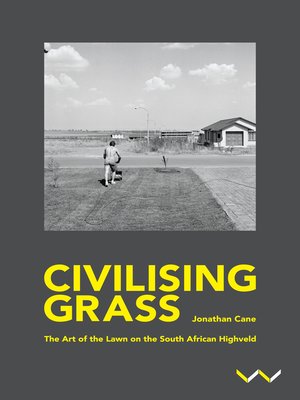
Sign up to save your library
With an OverDrive account, you can save your favorite libraries for at-a-glance information about availability. Find out more about OverDrive accounts.
Find this title in Libby, the library reading app by OverDrive.



Search for a digital library with this title
Title found at these libraries:
| Library Name | Distance |
|---|---|
| Loading... |
What does the lawn want? To be watered, fertilised, mowed, admired, fretted over, ignored? This unusual question serves as a starting point for Civilising Grass: The Art of the Lawn on the South African Highveld, an unexpected and often disconcerting critique of one of the most common and familiar landscapes in South Africa. The lawn, Jonathan Cane argues, is not quite as innocent as we might think. Besides the fact that lawns suck up scarce water, consume chemicals, displace indigenous plants and reduce biodiversity, they are also part of a colonial lineage of dispossession and violence. They reduce the political problem of land to the aesthetic question of landscape, thereby obscuring issues of ownership, redress, belonging and labour. The question then becomes: Who takes care of whose lawn, in what clothes, under what conditions and for what reward?
Civilising Grass offers a detailed reading of artistic, literary and architectural lawns between 1886 and 2017. The eclectic archive includes plans, poems, maps, gardening blogs, adverts, ethnographies and ephemera, as well as literature by Koos Prinsloo, Marlene van Niekerk and Ivan Vladislavić. In addition, the book includes colour reproductions of lawn artworks by David Goldblatt, Lungiswa Gqunta, Pieter Hugo, Anton Kannemeyer, Sabelo Mlangeni, Moses Tladi and Kemang Wa Lehulere. This book shows that even if the enchantment of a green, flat and soft lawn is almost universal, there are also unexpected moments when alternatives present themselves, occasions when people reject the politeness of the lawn, and situations in which we might glimpse a possible time after the lawn. Drawing on theory and conceptual tools from interdisciplinary fields such as ecocriticism, queer theory, art history and postcolonial studies, Civilising Grass offers the first sustained investigation of the lawn in Africa and contributes to the growing conversation about the complex relationships between humans and non-humans on the continent.|Civilising Grass is a socio-cultural analysis of the lawn on the South African highveld, exploring the complex relationship between landscape and power in the country's colonial, modernist and post-apartheid eras. Drawing from eco-criticism, queer theory, art history and postcolonial studies, this book offers a lively and provocative reading of texts and illustrations to reveal the racial and gendered aspects of 'natural' environments. It argues that the lawn, an ordinary and often overlooked feature of South African everyday life, is neither natural nor innocent. Rather, like other colonial landscapes, the lawn functions as a site of commonplace violence, of oppression, dispossession and segregation. This book explores an eclectic archive of artistic, literary and architectural lawns between 1886 and 2017, analysing poems, maps, gardening blogs, adverts, ethnographies and ephemera, as well as literature by Koos Prinsloo, Marlene van Niekerk and Ivan Vladislavić. In addition, Civilising Grass includes colour reproductions of lawn artworks by David Goldblatt, Lungiswa Gqunta, Pieter Hugo, Anton Kannemeyer, Sabelo Mlangeni, Moses Tladi and Kemang Wa Lehulere. Examination of these and other works reveals the organic relationship between lawn and wildness, and between lawn and human/non-human actors – thereby providing rich and unexpected insights into South African society past and present.







